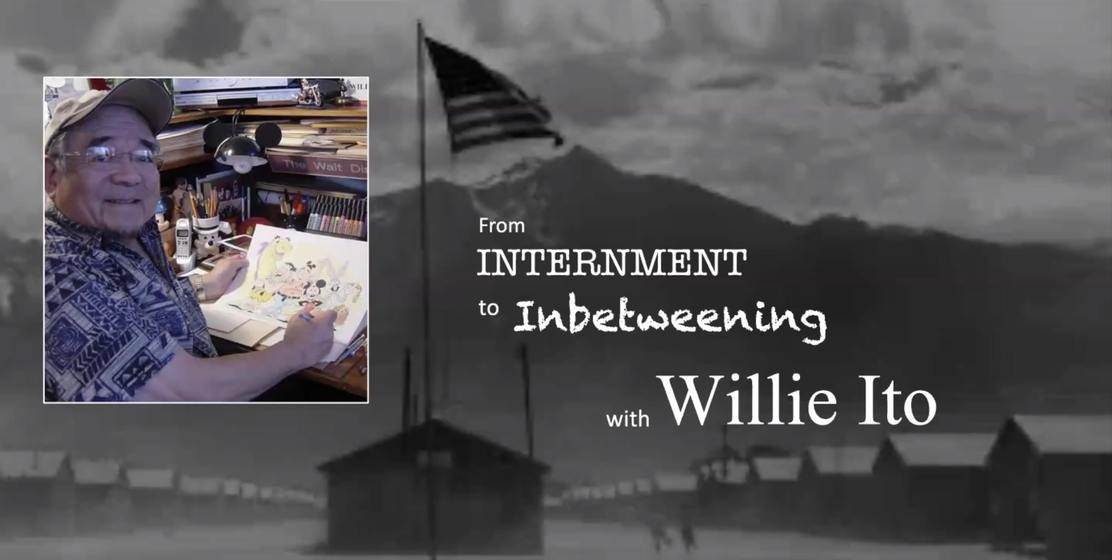The Walt Disney Family Museum hosted a special virtual event on August 29th called “From Internment to Inbetweening with Willie Ito,” a conversation with the Japanese American animator and Disney Historian Mindy Johnson. The artist, inspired by Disney from a young age, went on to work at Disney as an inbetweener on Lady and the Tramp and also leant his talents to Disney comics and consumer products. He also spent time working on some of the most famous Looney Tunes shorts and worked on classic Hanna-Barbera shows including The Flintstones, The Jetsons, and Scooby Doo, Where are You?
“As a kid of 8, I was somewhat impressionable,” Willie Ito shared about his San Francisco upbringing where he would collect Sunday newspaper comics pages and remembers seeing Walt Disney’s Snow White and the Seven Dwarfs when he was 5, developing a lifelong love for the character Dopey. “However, the only thing I really knew was San Francisco, a very cosmopolitan city, tall buildings.” Ito recounted the shock of being relocated to Japanese internment camps following the attack on Pearl Harbor. “Our first incarceration was Tanforan, it used to be a horse racing facility… to suddenly come out of your own home in San Francisco and to wake up and suddenly you’re in a horse stable, that was quite an awakening.” Willie spent nearly four years in an internment camp with his family, who were relocated to Topaz City, Utah.
When the 100,000 Japanese Americans were finally released, Willie’s family went back to San Francisco. “We were fortunate enough where my father had enough foresight to keep our home, had a Chinese family live in it, so we had a home to come back to.” He shared that most people had lost everything during their time in the internment camps and had to rebuild their lives from nothing. While many of the family’s heirlooms were confiscated by the FBI, never to be returned, Willie’s most prized possession was still waiting for him: a Dopey coin bank.
Ito eventually went to San Francisco City College to study art, but felt himself being pulled into a more humanitarian field, which was what a lot of his friends were doing with their lives. One of his teachers, however, had a connection at the Chouinard Art Institute who encouraged Willie to apply and he ended up receiving a scholarship. “I had a certain amount of anxiety because now I was leaving the comfort of my Japanese American community, my family, my friends… Now I was going to be venturing into the all-white world of Hollywood. I did have a lot of anxiety until I started in cartooning at Chouinard.”
One of Willie’s goals was to see the inside of Walt Disney Studios, not thinking he would be hired while still in school. He applied for a job just to get inside the building and was surprised to find another Japanese American co-leading his portfolio review, Iwao Takamoto. While on his way up to the fourth floor, Willie also found himself sharing an elevator with Walt Disney. “Walt sees me cowering in the back corner of the elevator and he gave me a polite nod.” A week later, Willie received a telegram asking him to come back in for a test and at just 19-years-old, Ito was offered a job as an inbetweener on Lady and the Tramp.
After production on Lady and the Tramp wrapped, Willie was told there was no more work for him until Sleeping Beauty started up, which was going to be about a three-month break. During that time, Willie contacted a friend at Termite Terrace who hired him and another Disney animator to work on Looney Tunes shorts, including “One Froggy Evening.” Chuck Jones and Fritz Freeling referred Willie to Hanna-Barbera, who’s TV projects were getting off the ground in a big way and Ito worked with them on classics like The Flintstones, but also helped bring more diversity to animation through shows like The Super Globetrotters and The Amazing Chan and the Chan Clan.
While Willie Ito never went back to Disney Animation, he did return to Disney. A freelance job making comics for Disney led to a job at Disney Consumer Products, where he helped unify the merchandise lines at Disney Store’s international locations.
Things have come full circle for Willie Ito, who’s time as a child in internment camps inspired two book projects he illustrated, Hello Maggie and A Boy of Heart Mountain. He’s currently working on an updated edition of Hello Maggie to coincide with an animated short adaptation, expected to be released in summer 2021.

